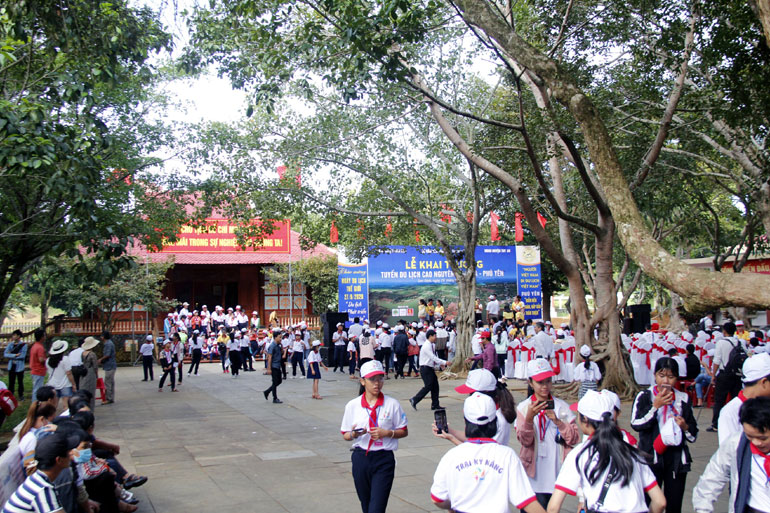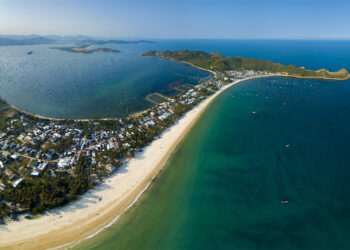On April’s days with brilliant golden sunshine, in joyful direction towards the celebration of the complete liberation of the Southern provinces, reunification (the day of April 30th) and the birthday of the great President Ho Chi Minh (May 19th), we returned to the base area of Phu Yen province during the war against the US army. The three communes of Van Hoa plateau, including: Son Xuan, Son Long and Son Dinh (in the north of Son Hoa district), were revolutionary bases in the past because of rugged forests; today, a picture of a new life exists and is one of the destinations to attract tourists from near and far.
 |
| Uncle Ho temple, an indispensable source destination in the tourism route to the Van Hoa plateau |
The April sunshine in Van Hoa highlands is not exhausting, burning but sweet, even the soft cool midday breeze of a temperate climate.
Van Hoa plateau, where the Provincial Party Committee previously chose to serve as a base for the long-time war, because the terrain was extremely dangerous, and difficult for the enemy to detect, our army were easy to maneuver, retreat into the mountains when encountering dangerous situation. In 1962, Phu Yen Provincial Party Committee decided to move the agency here to build a resistance base area. After that, the provincial Party committee, government, Front, military, police, infirmary, financial, trade, communication agencies… all moved here until the province was completely liberated (April, 1975).
Uncle Ho’s temple was built by Phu Yen Provincial Party Committee in early September 1969 at Da slope, Son Dinh commune, when receiving news that President Ho Chi Minh passed away. This was also the place where Uncle Ho’s memorial ceremony was held on September 9th, 1969 and a place for the people of Phu Yen to commemorate Uncle Ho during the war against the US army. In 2003, the relic was restored and embellished in an area of more than 5,000 square meters, right next to DT643 road. In 2008, the whole complex of relics of the Base of Phu Yen province during the war against the US army, in which the highlight was Uncle Ho temple invested in embellishment and recognized by the Ministry of Culture, Sports and Tourism as a historical relic at national level. This place becomes a red address for generations of veterans, young people to go on pilgrimage to the source, review history, traditional education and to announce Uncle Ho on special occasions.
Speaking of Phu Yen, in addition to the potential strength of the sea and islands, the Van Hoa plateau is considered a tourist area with typical products of the mountainous region. It has an average altitude of about 400m above sea level; with uninterrupted mountainous terrain, many mountains, lakes, streams, waterfalls, cool climate all year round are favorable conditions for developing ecotourism in association with visiting relics and learning cultural history…
The most characteristic of this highland is the climate. In the middle of the extremely hot season in the Central region, but just stepping across the border of Van Hoa plateau, less than 40 kilometers from Tuy Hoa city, the climate has changed its “state” to cool and comfortable air like Da Lat’s.
The Van Hoa plateau is famous for avocado, jackfruit, banana, pomelo… Recently, an emerging tree that attracts many tourists from inside and outside the province to visit is the red orchard. Red trees have fruit branches spread around the trunk to branches. When ripe, they create an eye-catching bright red color. Red trees are most concentrated in Son Xuan commune. In the recent years, people take advantage of this and renovate it into a garden house for guests to visit, eat and rest. According to Mr. Bon Cu (Bon Cu’s Red Garden), earlier, the red trees growing wild in the forest, when they cleared up for making the fields, people realized they are edible fruits, so they were retained. Because of its uniqueness combined with a cool, fresh climate, the unique local dishes have been being developed into the local typical tourism products.
The rich cuisine of Van Hoa plateau, featuring chicken cooked with pineapple fish sauce, chicken with “giang” leaves, and “dit” leaves, is a must-have dish. Even the super chef of Ly Sanh, Head of Saigon Professional Kitchen also praised these local dishes.
The historical cultural relics, natural landscapes are also the basic pillars that make up the features of this land when developing tourism. In addition to the Uncle Ho temple, Spring Hall, there are other interesting natural attractions, such as Han waterfall, Da stream (Son Xuan commune), Suoi Phen lake, Da Nha gulf (Son Long commune), Che stream (Son Dinh commune)… is also listed in the travel handbook of visitors who love to explore and experience.
With such potential, along with the promotion and calling for investment attraction, during the recent years, many businesses, economic and tourism projects, such as: BB High-tech Farm, Long Van Garden eco-tourism area (Son Long commune), Tam Thanh Dat stopover, TH True milk high-tech cow raising area… have come to this land. All have contributed to creating a rich and increasingly exciting tourism picture when coming to this temperate highland area.
The Department of Culture, Sports and Tourism has recently announced a local tourism route to the Van Hoa plateau, associated with the relics of the ancient revolutionary base and destinations, such as the Son Xuan red garden, Uncle Ho temple and other historical, cultural, and scenic relics; Long Van ecological area, BB Farm in Son Long commune; connecting with national relic Thi Thung mount tunnel (An Xuan commune, Tuy An district).
Source: Phu Yen Newspaper
Translated by TRINH THUY












Discussion about this post